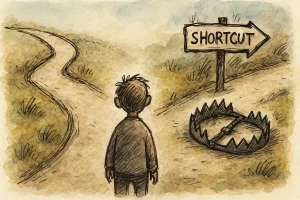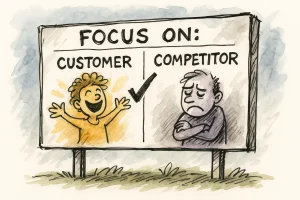
Almost everything worthwhile seems complicated at first: selling consistently, organizing finances, delivering on time, learning a skill. The trick isn’t to “be a genius” – it’s to remove friction until the difficult fits into your everyday routine. Making things easy isn’t about sugarcoating reality – it’s about breaking the problem into manageable pieces you can move now.
Where to Start
- Define the outcome in one line: “Deliver proposals within 48 hours.” “Respond to clients within 24 hours.” “Close the cash register every Friday.” If it doesn’t fit in a sentence, it’s still a wish.
- Break it into minimal steps: List 3–5 steps. More than that complicates things. Example: capture order → draft proposal → review with checklist → send.
- Create automatic triggers: Received an order? Generate the task and set a standard date. No “I’ll see later.” Each action triggers the next.
- Standardize recurring tasks: Templates, checklists, canned responses. Standards don’t constrain – they free time for tasks that require thinking.
- Use short, frequent deadlines: Instead of a monthly push, use daily 30–50 minute blocks. Consistency beats sporadic intensity.
- Remove environmental noise: Turn off notifications, name files clearly, keep materials at hand. Organization is part of the solution, not a luxury.
Simple Tools That Work
- Quality checklist: 5 items every delivery must meet.
- Templates: proposal, billing email, customer service script.
- Visible board: to-do / in progress / done, with owners and dates.
- Focus windows: two daily blocks at the same time.
- Weekly 20-minute review: what worked, what stalled, what to change.
Practical Examples
- Customer Service
- Difficult: respond to everything without missing anyone.
- Easy: inbox zero at 11 a.m. and 4 p.m. / standard replies for 80% of cases / priority triage / agreed return times.
- Commercial Proposals
- Difficult: each proposal is a new document.
- Easy: three clear-scope packages / editable block template / simple cost and margin spreadsheet / 48-hour turnaround goal.
- Cash Flow
- Difficult: numbers scattered, surprises at month-end.
- Easy: spreadsheet with input/output dates /10-minute daily updates / automatic reminders / rule: “never sell with longer payment terms than supplier’s”.
- Team Training
- Difficult: lengthy content that gets forgotten.
- Easy: 15-minute micro-training per week, one topic at a time, with practical exercise and learning record.
How to Decide What to Simplify
- High impact + high frequency: start here. Critical, repeated processes deserve immediate standardization.
- High impact + low frequency: create a quick guide for when it occurs.
- Low impact + high frequency: automate or eliminate.
- Low impact + low frequency: ignore for now.
Rules to Avoid Returning to the Difficult
- Make completed work visible: check on the board, short report, client confirmation.
- Turn errors into process adjustments: make the mistake once, fix the cause.
- The standard is the standard: document exceptions, no shortcuts.
- The calendar protects priorities: if everything is urgent, nothing is important.
7-Day Roadmap
- Day 1: pick the most painful process. Write the outcome sentence.
- Day 2: break it into 3–5 steps.
- Day 3: create one checklist and one template.
- Day 4: set up the visible board and assign owners.
- Day 5: complete the first full cycle; measure time and errors.
- Day 6: remove a useless or automated step.
- Day 7: record improvements and choose the next process to simplify.
What to Avoid
- Over-engineering small problems: expensive systems for tasks a spreadsheet can handle.
- Long meetings without decisions: every discussion ends with “who does what by when”.
- Perfectionism disguised as quality: clear standard > endless quest for “one more tiny detail.”
Why does this matter?
Because complexity is costly: time, energy, money, and reputation. When you make the difficult easy, you free focus for value-generating work, reduce errors, create predictability, and improve the experience for both your team and your clients. Simplifying isn’t cutting corners… it’s opening the path so important work gets done – every day.





